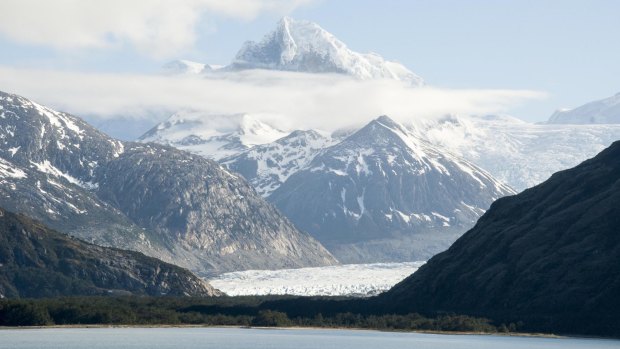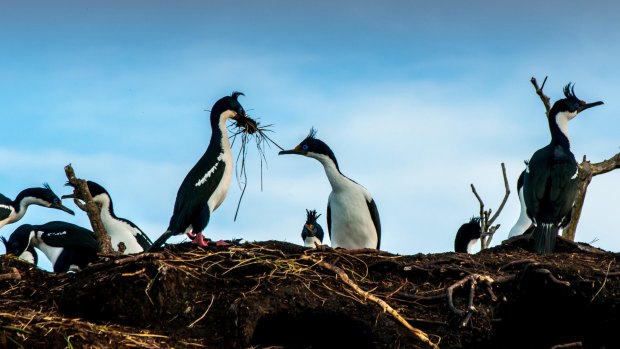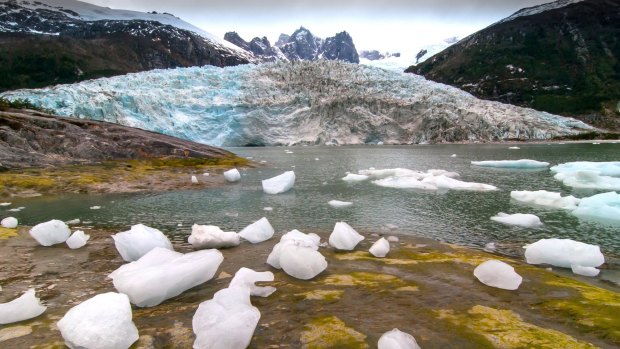This was published 5 years ago
Patagonia: Apocalyptic one day, sunny perfection the next
By Keith Austin

Cruising in Glacier Alley, where five different glaciers flow.Credit: Shutterstock
Even in stinging sleet and sideways rain there is a savage beauty about the southern Patagonian landscape. It's 9am and we're standing on a lonely gobbet of land in Ainsworth Bay, just off Admiralty Sound in Chile's Tierra del Fuego region.
Our ship, the Ventus Australis, is moored offshore and we have just tumbled out of the Zodiacs like so many Teletubbies, all layered up with lifejackets and brightly coloured wet weather gear.
Thanks to advice from the crew last night to "dress like an onion" in preparedness for Patagonia's notoriously fickle weather, I am wearing thermal long johns, socks, thermal socks, a thermal T-shirt, a polo neck jumper, a hoody, a new raincoat, cargo pants, waterproof over-trousers and what I hope to God are waterproof boots.

Cormorants in Tierra del Fuego, just some of the wildlife to be discovered in Patagonia.Credit: Shutterstock
And I'm still freezing.
From the narrow, scrappy beach the ground gives way to a boggy, soggy expanse of tough, low-lying plants punctuated by rocks spattered with lichen and algae. Past this there are a few stands of stunted, wind-swept trees that gradually merge into the vast, snow-dusted forest that creeps up the mountainside beyond.
It's only later, when our guided walk is over and the sleet and the rain ease off, that we realise there is an even bigger mountain range beyond this one – a vast expanse of snow and ice known as the Cordillera Darwin, which includes, at up to 2000 metres, the highest mountains in Tierra del Fuego.

Pia glacier in Tierra del Fuego, Patagonia.Credit: Shutterstock
It's quietly apocalyptic, the sort of scenery you'd expect Liam Neeson to tumble out of, fighting off a pack of wolves with his teeth and the contents of the minibar. I find myself wondering, if push came to shove, which one of my companions I'd eat first.
We had joined the Ventus Australis the previous evening in Punta Arenas, the capital of Chile's southernmost Magallanes and Antarctica Chilena region. The city sits on the northern section of the Strait of Magellan, named after the Portuguese explorer who was the first European to navigate the strait in 1520. How he managed this is almost beyond imagining, given that a map of this far-flung region at the bottom of the world looks like a five-year-old has thrown a tantrum with a giant jigsaw.
Our ship is just one year old and still under guarantee. The company's other ship, the Stella Australis, will pass us going the other way a few days hence. Small enough to get in and out of some of the shallower fiords and bays, the ships carry a maximum of 210 passengers – all in ocean-view cabins – with a crew of 65 sailors, expedition guides and hotel staff.
On the first night, as the ship prepares for an 8pm departure, we gather in the lounges for the obligatory safety and information evening. Outside the evening twilight turns to grey amid gusting winds and sputtering rain. Inside we are drinking pisco sours and Patagonian beers with guests from 16 different nations. There are people from the US, Australia, New Zealand, France, Brazil, Slovenia and Israel, among others, and the demographic is younger and fitter than many other, bigger cruises. These are people who love an expedition, a good hike and a modicum of adventure. And the all-inclusive bar in the evening. Or maybe that was just me.
When the ship leaves port, we are told, it's the last time we'll see a human settlement for four days. Ahead of us are sea lions, dolphins, penguins, cormorant colonies, glaciers, infamous Cape Horn and, finally, the fin del mundo (end of the world). Or the Argentinian city of Ushuaia, as it's better known.
The next day doesn't dawn at all. You'd have to see the sun for that and what's outside my cabin window is grey upon grey upon grey – JMW Turner at his most tenebrous. The water is flat and calm, a dark slick that reminds me of the colour of Welsh slate roof tiles in the rain. It also seems oddly sluggish, as if the cold (it is 4 degrees outside) has caught it somewhere just before it turns into a slushy.
I take a double espresso up to the top deck. There are what look like low-lying islands off the port bow but seen through the fine drizzle and morning mist they are insubstantial, spectral. I'm reminded for some reason of The Tempest. If we landed over there what strange Calibans would we encounter?
The weather at Ainsworth Bay gets worse before it gets better but Enzo is an enthusiastic and knowledgeable guide and at times it's almost possible to forget we're standing around examining a piece of algae in a raging sleet storm.
Enzo introduces us to the wonders of the winter's bark (used to prevent scurvy and discovered by one Captain Winter) and the devil's strawberry, a tiny fruit that the local Yagan people used to use as a laxative after eating one too many rancid whale burgers.
In the afternoon we board the Zodiacs again for small group tours around the Tuckers Islets and close encounters with the penguins that live on these tiny dots. We are also lucky enough to see a huge sea lion posing haughty and unafraid on one end of the cormorants' nesting ground.
The penguins are ludicrous and ludicrously cute; their small island somewhat redolent of an abandoned nappy (the cormorants aren't much better). We also learn from our guide that the slang name for penguins hereabouts is chorretada or "diarrhoea" because of the speed with which food shoots through their systems. "They basically eat and shit almost immediately," he laughs.
At the evening briefing (which includes a lecture on how glaciers are the Michelangelos of the Patagonian landscape) we're told that the weather forecast for the next day or two is "unpredictable – welcome to Patagonia".
And so it proves because day two is as different from day one as it is possible to get. There isn't a cloud in a Marrakech blue sky and by 2pm we are moored a few hundred yards from the Pia Glacier just off the Beagle Channel.
The inlet is glistening with chunks of crystal-clear ice that have fallen off the glacier and we thump into a few of them with the Zodiac on the way to the landing ground just below this pastel-blue behemoth.
On land we walk up to a vantage point and take a moment to sit in companionable silence. It is magnificent. One of those moments, especially when there's a thunderous crack and another small iceberg calves into the water with a splash, that makes you glad to be alive, right here, right now.
The afternoon is spent on the ship, motoring through Glacier Alley – a section of the Beagle Channel where five different glaciers flow, if that's the right word, from the Darwin Mountain range. They're named after European countries – Germany, France, Italy, Spain and Holland – and as each glacier appears we are entertained with music, food and drinks from the country in question.
On the third day we are supposed to get off the ship at Cape Horn, the rocky, 425-metre high promontory sitting at the real end of the world. It is bleak and lonely here, the place where the Pacific clashes with the Atlantic just 650 kilometres north of Antarctica,
From the ship we can see the lighthouse that overlooks Drake Passage but the weather conditions forbid it. It's not so bad for the ship but taking the Zodiacs across to the island is too dangerous. Instead Captain Adolfo Navarro decides to sail around Cape Horn, something about which even our guides are excited.
That afternoon we drop anchor at Wulaia Bay and go ashore for a strenuous hike up to a panoramic lookout and a squiz around the information centre housed in an old radio station.
Patagonia, though, has one more weather trick up its sleeve. As we board the Zodiacs to go ashore it starts to snow, transforming a simple hike into a passage through a fairytale landscape. It's cold, muddy – more than one of us goes to ground in the slushier parts – but the good natured snowball fights and the grins say it all. Apocalyptic one day, sunny perfection the next, and Narnia to top it off.
You won't get exactly that, if you go. After all, Patagonia is unpredictable. And that's part of the adventure.
TRIP NOTES
The writer was a guest of LATAM Airlines, APT and Australis.
MORE
FLY
LATAM Airlines flies to Santiago daily from Sydney and three times a week from Melbourne. Flights from Santiago to Punta Arenas depart five times a day. See latam.com
CRUISE
APT hosts custom travel service Tailor Made Journeys throughout South America, which includes sailing tours of Tierra del Fuego and Cape Horn with Australis. See aptouring.com.au and australis.com
.
Sign up for the Traveller Deals newsletter
Get exclusive travel deals delivered straight to your inbox. Sign up now.